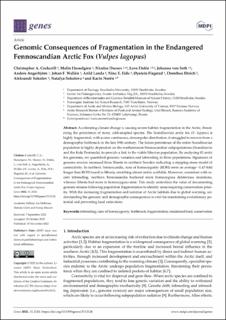| dc.contributor.author | Cockerill, Christopher A. | |
| dc.contributor.author | Hasselgren, Malin | |
| dc.contributor.author | Dussex, Nicolas | |
| dc.contributor.author | Dalén, Love | |
| dc.contributor.author | von Seth, Johanna | |
| dc.contributor.author | Angerbjörn, Anders | |
| dc.contributor.author | Wallén, Johan F. | |
| dc.contributor.author | Landa, Arild | |
| dc.contributor.author | Eide, Nina Elisabeth | |
| dc.contributor.author | Flagstad, Øystein | |
| dc.contributor.author | Ehrich, Dorothee | |
| dc.contributor.author | Sokolov, Aleksandr | |
| dc.contributor.author | Sokolova, Natalya | |
| dc.contributor.author | Norén, Karin | |
| dc.date.accessioned | 2023-03-06T16:02:56Z | |
| dc.date.available | 2023-03-06T16:02:56Z | |
| dc.date.created | 2022-11-16T14:20:29Z | |
| dc.date.issued | 2022 | |
| dc.identifier.issn | 2073-4425 | |
| dc.identifier.uri | https://hdl.handle.net/11250/3056191 | |
| dc.description.abstract | Accelerating climate change is causing severe habitat fragmentation in the Arctic, threatening the persistence of many cold-adapted species. The Scandinavian arctic fox (V. lagopus) is highly fragmented, with a once continuous, circumpolar distribution, it struggled to recover from a demographic bottleneck in the late 19th century. The future persistence of the entire Scandinavian population is highly dependent on the northernmost Fennoscandian subpopulations (Scandinavia and the Kola Peninsula), to provide a link to the viable Siberian population. By analyzing 43 arctic fox genomes, we quantified genomic variation and inbreeding in these populations. Signatures of genome erosion increased from Siberia to northern Sweden indicating a stepping-stone model of connectivity. In northern Fennoscandia, runs of homozygosity (ROH) were on average ~1.47-fold longer than ROH found in Siberia, stretching almost entire scaffolds. Moreover, consistent with recent inbreeding, northern Fennoscandia harbored more homozygous deleterious mutations, whereas Siberia had more in heterozygous state. This study underlines the value of documenting genome erosion following population fragmentation to identify areas requiring conservation priority. With the increasing fragmentation and isolation of Arctic habitats due to global warming, understanding the genomic and demographic consequences is vital for maintaining evolutionary potential and preventing local extinctions. inbreeding; runs of homozygosity; bottleneck; fragmentation; mutational load; conservation | en_US |
| dc.language.iso | eng | en_US |
| dc.publisher | MDPI | en_US |
| dc.rights | Navngivelse 4.0 Internasjonal | * |
| dc.rights.uri | http://creativecommons.org/licenses/by/4.0/deed.no | * |
| dc.title | Genomic Consequences of Fragmentation in the Endangered Fennoscandian Arctic Fox (Vulpes lagopus) | en_US |
| dc.title.alternative | Genomic Consequences of Fragmentation in the Endangered Fennoscandian Arctic Fox (Vulpes lagopus) | en_US |
| dc.type | Peer reviewed | en_US |
| dc.type | Journal article | en_US |
| dc.description.version | publishedVersion | en_US |
| dc.source.volume | 13 | en_US |
| dc.source.journal | Genes | en_US |
| dc.identifier.doi | 10.3390/genes13112124 | |
| dc.relation.project | Andre: Swedish Research Council FORMAS | en_US |
| dc.relation.project | EU/EU/Interreg Nord to Felles Fjellrev Nord II, 0203530 | en_US |
| dc.relation.project | EU/EU-Life SEFALO | en_US |
| dc.relation.project | EU/EU/Interreg Sweden- Norway to Felles Fjellrev I, 04-4159-13 | en_US |
| dc.relation.project | EU/EU/Interreg Nord to Felles Fjellrev Nord I, 20201086 | en_US |
| dc.relation.project | EU/EU-Life SEFALO+ | en_US |
| dc.relation.project | Andre: Göran Gustafssons stiftelse för natur och miljö i Lappland | en_US |
| dc.relation.project | Andre: Carl Tryggers Foundation grant number CTS 19: 257 | en_US |
| dc.relation.project | EU/EU/Interreg Sweden- Norway to Felles Fjellrev II, 20200939 | en_US |
| dc.relation.project | Norges forskningsråd: 244557; | en_US |
| cristin.ispublished | true | |
| cristin.fulltext | original | |
| cristin.qualitycode | 1 | |

